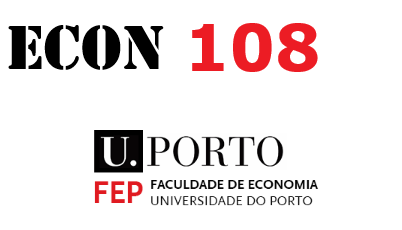ARMA models
Contents
ARMA models¶
Time series models¶
aim to capture complex temporal dependence
parsimoniously…
MA can be very flexible, but is not parsimonious
AR can be very parsimonious but is less flexible
ARMA models can be a way to achieve both flexibility and parsimony
ARMA(p, q)¶
\(\alpha_p \neq 0\), \(\beta_q \neq 0\)
in lag operator notation
ARMA(1, 1)¶
Stationarity and invertibility¶
ARMA(p, q) is stationary if the AR§ part is stationary, i.e. if all roots of the polynomial
are outside the unit circle (\(|x|>1\))
ARMA(p, q) is invertable if the MA(q) part is invertable, i.e. if all roots of the polynomial
are outside the unit circle (\(|x|>1\))
import warnings
warnings.simplefilter("ignore", FutureWarning)
warnings.simplefilter("ignore", UserWarning)
from statsmodels.tools.sm_exceptions import ConvergenceWarning
warnings.simplefilter('ignore', ConvergenceWarning)
import numpy as np
from numpy.random import default_rng
from statsmodels.tsa.arima_process import arma_acovf, ArmaProcess
from statsmodels.tsa.arima.model import ARIMA
import statsmodels.tsa.api as smt
np.set_printoptions(precision=3, suppress=True)
example: ARMA(1,1) in Python
alpha = np.array([.8])
beta = np.array([0.1])
ar = np.r_[1, -alpha] # coefficient on z(t) and z(t-1)
ma = np.r_[1, beta] # coefficients on e(t) and e(t-1)
arma11_process = ArmaProcess(ar, ma)
print(arma11_process)
ArmaProcess
AR: [1.0, -0.8]
MA: [1.0, 0.1]
print(arma11_process.arroots)
print(arma11_process.maroots)
[1.25]
[-10.]
arma11_process.isstationary
True
arma11_process.isinvertible
True
arma11_process.acovf(10)
array([3.25 , 2.7 , 2.16 , 1.728, 1.382, 1.106, 0.885, 0.708, 0.566,
0.453])
arma11_process.acf(10)
array([1. , 0.831, 0.665, 0.532, 0.425, 0.34 , 0.272, 0.218, 0.174,
0.139])
arma11_process.arma2ma(15)
array([1. , 0.9 , 0.72 , 0.576, 0.461, 0.369, 0.295, 0.236, 0.189,
0.151, 0.121, 0.097, 0.077, 0.062, 0.049])
# impulse responses
arma11_process.impulse_response(15)
array([1. , 0.9 , 0.72 , 0.576, 0.461, 0.369, 0.295, 0.236, 0.189,
0.151, 0.121, 0.097, 0.077, 0.062, 0.049])
Estimation of ARMA models by MLE¶
if \(\mathbf{z}\) is a sample from an ARMA processes, it can be represented as (try it for ARMA(1,1))
where \(\boldsymbol C\) is invertible. Therefore, we can express \(\mathbf{z}\) as
With
we have
where
Therefore, this is a gaussian model
where \(\mathbf{\theta}\) collects the AR coefficients (\(\boldsymbol \alpha = \left[\alpha_0, \alpha_1, \alpha_2, \cdots, \alpha_p \right]\)), the MA coefficients (\(\boldsymbol \beta = \left[\beta_1, \beta_2, \cdots, \beta_q \right]\)), and \(\sigma^2\).
and we can use the Gaussian MLE to obtain \(\hat {\boldsymbol \theta}\)
Log-likelihood¶
Equivalently, by stationarity, the covariance matrix \(\mathbf{\Sigma}\) has Toeplitz structure
Note
In practice, the log-likelihood function is evaluated using the Kalman filter (will be discussed later)
ARMA estimation in Python¶
arma11_process.arroots, arma11_process.maroots
(array([1.25]), array([-10.]))
gen = default_rng(1)
T=700
z = arma11_process.generate_sample(T, distrvs=gen.normal)
arma_model = ARIMA(z, order=(1, 0, 1), trend="n")
arma_results = arma_model.fit()
print(arma_results.summary())
SARIMAX Results
==============================================================================
Dep. Variable: y No. Observations: 700
Model: ARIMA(1, 0, 1) Log Likelihood -972.782
Date: Mon, 14 Mar 2022 AIC 1951.564
Time: 10:44:58 BIC 1965.218
Sample: 0 HQIC 1956.842
- 700
Covariance Type: opg
==============================================================================
coef std err z P>|z| [0.025 0.975]
------------------------------------------------------------------------------
ar.L1 0.7903 0.028 28.455 0.000 0.736 0.845
ma.L1 0.0822 0.044 1.874 0.061 -0.004 0.168
sigma2 0.9417 0.049 19.248 0.000 0.846 1.038
===================================================================================
Ljung-Box (L1) (Q): 0.03 Jarque-Bera (JB): 0.42
Prob(Q): 0.86 Prob(JB): 0.81
Heteroskedasticity (H): 1.38 Skew: -0.00
Prob(H) (two-sided): 0.02 Kurtosis: 3.12
===================================================================================
Warnings:
[1] Covariance matrix calculated using the outer product of gradients (complex-step).
arma11_process
ArmaProcess([1.0, -0.8], [1.0, 0.1], nobs=100) at 0x21055846e60
Model selection¶
need to determine \(p\) (the order of AR part) and \(q\) (the order of MA part)
by balancing model fit and model complexity
want models that capture well the termporal dependence in the data but do it in a parsimonious way
Information criteria: combine a measure of how well a model fits the data with a penalty for the complexity of the model, related the number of model parameters
simpler models are preferred to complex ones if the fit is not much worse.
Everything should be made as simple as possible, but no simpler
Let \(k=p+q+1\) (dimension of \(\mathbf{\theta}\)) and \(\hat{\mathbf{\theta}}\) be the MLE
Note
BIC aka as Schwarz Information Criterion
Larger \(\ell(\hat{\mathbf{\theta}} | \mathbf{z})\) means better fit
Larger \(k\) means more parameters (higher complexity)
Lower values of IC are better
In AIC, the penalty for complexity does not depend on the sample size
in BIC it does
as long as \(\log(T)> 2\) the BIC tends to select models with fewer parameters than AIC
Model selection procedure:¶
define a set of models
estimate each one and compute IC
pick the one with lowest IC value
Caveats
AIC and BIC may select different models
they are meant to select the “true” model, but all models are wrong
BIC is designed to find the true model, not best-ftting one (one reason to favor AIC)
Sometimes other criteria may be preferable, depending on the application (e.g. forecasting)
ARMA Model selection in Python¶
res_IC = smt.arma_order_select_ic(z,
ic=["aic", "bic"],
trend="n",
max_ar=5,
max_ma=5,)
res_IC['aic']
| 0 | 1 | 2 | 3 | 4 | 5 | |
|---|---|---|---|---|---|---|
| 0 | 2719.340776 | 2239.261973 | 2096.383447 | 2031.290866 | 1992.290360 | 1971.391897 |
| 1 | 1952.156686 | 1951.564413 | 1950.097669 | 1950.702283 | 1952.641670 | 1954.071994 |
| 2 | 1952.018481 | 1948.774677 | 1950.764090 | 1952.679354 | 1954.599932 | 1954.273888 |
| 3 | 1950.620916 | 1950.765701 | 1949.777548 | 1951.359154 | 1953.032386 | 1956.223225 |
| 4 | 1950.466444 | 1952.466307 | 1951.384101 | 1953.193051 | 1954.384883 | 1955.607200 |
| 5 | 1952.466123 | 1954.427275 | 1953.013563 | 1955.396999 | 1952.649950 | 1955.436449 |
res_IC['bic']
| 0 | 1 | 2 | 3 | 4 | 5 | |
|---|---|---|---|---|---|---|
| 0 | 2723.891856 | 2248.364134 | 2110.036688 | 2049.495187 | 2015.045761 | 1998.698379 |
| 1 | 1961.258847 | 1965.217654 | 1968.301990 | 1973.457685 | 1979.948152 | 1985.929557 |
| 2 | 1965.671722 | 1966.978998 | 1973.519492 | 1979.985836 | 1986.457494 | 1990.682531 |
| 3 | 1968.825237 | 1973.521102 | 1977.084030 | 1983.216716 | 1989.441028 | 1997.182948 |
| 4 | 1973.221846 | 1979.772789 | 1983.241664 | 1989.601694 | 1995.344606 | 2001.118004 |
| 5 | 1979.772605 | 1986.284837 | 1989.422206 | 1996.356722 | 1998.160754 | 2005.498332 |
print(res_IC.aic_min_order)
print(res_IC.bic_min_order)
(2, 1)
(1, 0)
